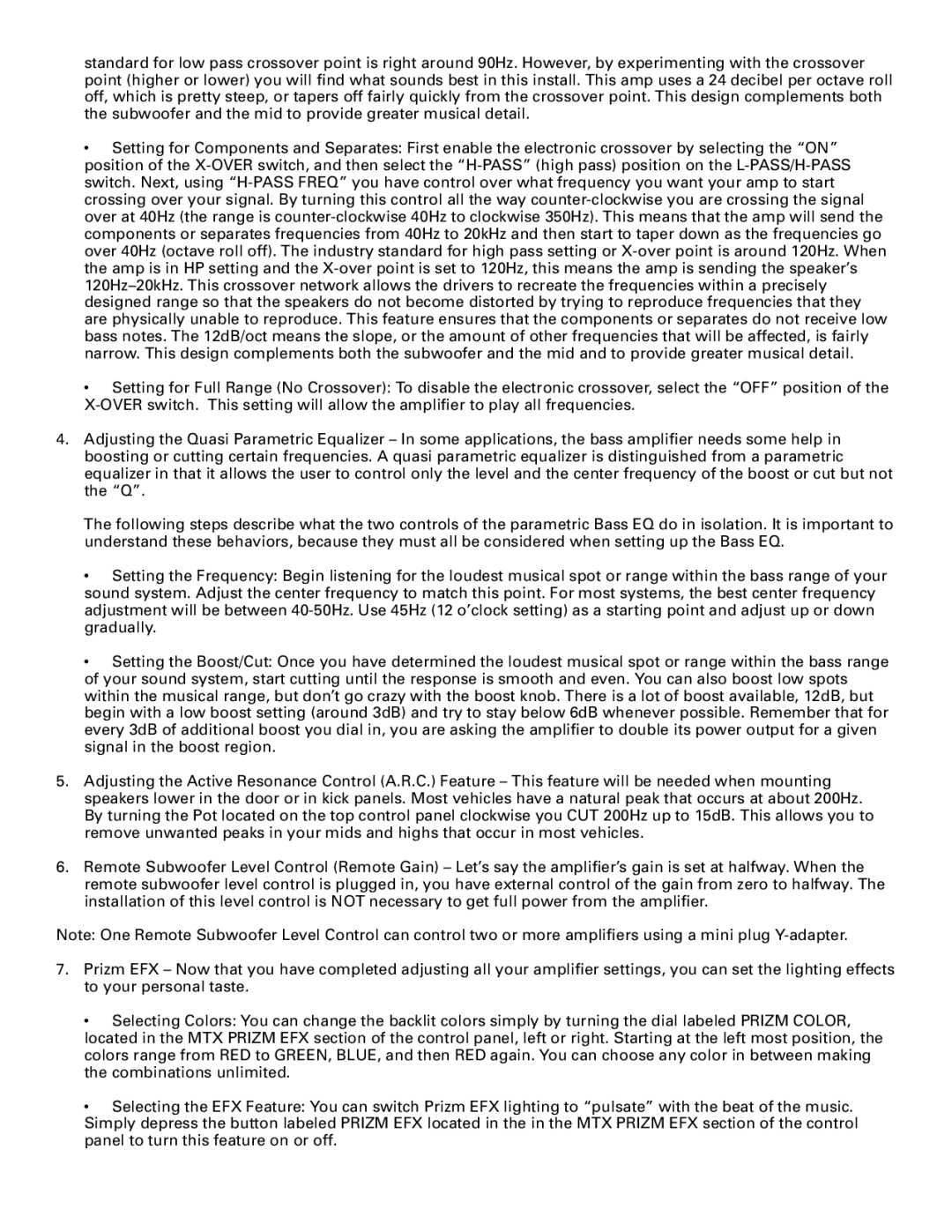standard for low pass crossover point is right around 90Hz. However, by experimenting with the crossover point (higher or lower) you will find what sounds best in this install. This amp uses a 24 decibel per octave roll off, which is pretty steep, or tapers off fairly quickly from the crossover point. This design complements both the subwoofer and the mid to provide greater musical detail.
•Setting for Components and Separates: First enable the electronic crossover by selecting the “ON” position of the
•Setting for Full Range (No Crossover): To disable the electronic crossover, select the “OFF” position of the
4.Adjusting the Quasi Parametric Equalizer – In some applications, the bass amplifier needs some help in boosting or cutting certain frequencies. A quasi parametric equalizer is distinguished from a parametric equalizer in that it allows the user to control only the level and the center frequency of the boost or cut but not the “Q”.
The following steps describe what the two controls of the parametric Bass EQ do in isolation. It is important to understand these behaviors, because they must all be considered when setting up the Bass EQ.
•Setting the Frequency: Begin listening for the loudest musical spot or range within the bass range of your sound system. Adjust the center frequency to match this point. For most systems, the best center frequency adjustment will be between
•Setting the Boost/Cut: Once you have determined the loudest musical spot or range within the bass range of your sound system, start cutting until the response is smooth and even. You can also boost low spots within the musical range, but don’t go crazy with the boost knob. There is a lot of boost available, 12dB, but begin with a low boost setting (around 3dB) and try to stay below 6dB whenever possible. Remember that for every 3dB of additional boost you dial in, you are asking the amplifier to double its power output for a given signal in the boost region.
5.Adjusting the Active Resonance Control (A.R.C.) Feature – This feature will be needed when mounting speakers lower in the door or in kick panels. Most vehicles have a natural peak that occurs at about 200Hz. By turning the Pot located on the top control panel clockwise you CUT 200Hz up to 15dB. This allows you to remove unwanted peaks in your mids and highs that occur in most vehicles.
6.Remote Subwoofer Level Control (Remote Gain) – Let’s say the amplifier’s gain is set at halfway. When the remote subwoofer level control is plugged in, you have external control of the gain from zero to halfway. The installation of this level control is NOT necessary to get full power from the amplifier.
Note: One Remote Subwoofer Level Control can control two or more amplifiers using a mini plug
7.Prizm EFX – Now that you have completed adjusting all your amplifier settings, you can set the lighting effects to your personal taste.
•Selecting Colors: You can change the backlit colors simply by turning the dial labeled PRIZM COLOR, located in the MTX PRIZM EFX section of the control panel, left or right. Starting at the left most position, the colors range from RED to GREEN, BLUE, and then RED again. You can choose any color in between making the combinations unlimited.
•Selecting the EFX Feature: You can switch Prizm EFX lighting to “pulsate” with the beat of the music. Simply depress the button labeled PRIZM EFX located in the in the MTX PRIZM EFX section of the control panel to turn this feature on or off.
